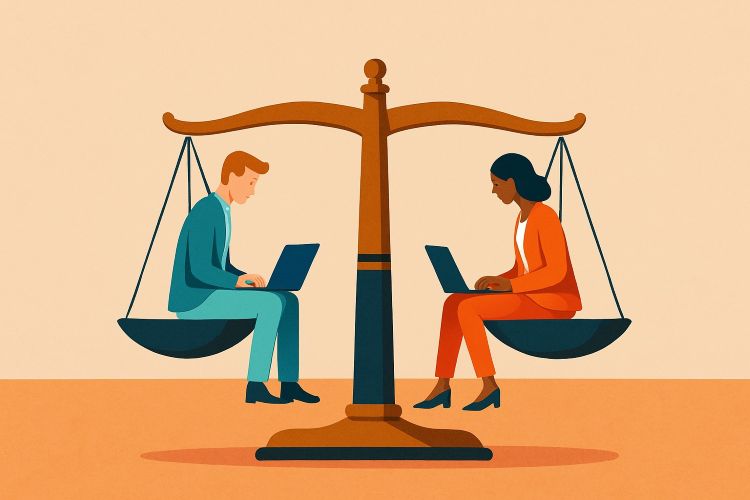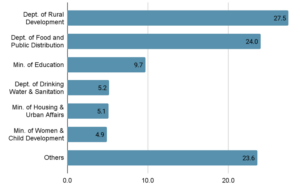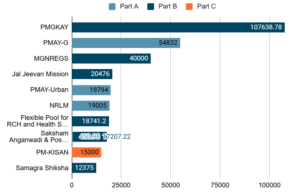
In recent years, India has witnessed a significant broadening of gender-responsive budgeting. But the question remains—will these developments translate into meaningful improvements in gender equality, or will they merely result in incremental progress? The Union Budget 2025-26 offers a measure of optimism for advocates of gender-responsive budgeting. Gender budget allocations surged to Rs 4.49 lakh crore, marking a robust 37.3% increase over the previous year’s budget estimates.
The allocation accounts for 8.9% of total Union government expenditure, a sharp rise from 6.8% in 2024-25 and well above the historic average of around 5% since the inception of the Gender Budget Statement (GBS) in 2005-06. Notably, the gender budget now represents 1.38% of GDP—the highest proportion to date.
READ I India’s semiconductor push: Ambition meets harsh realities
Allocations in the Gender Budget Statement 2025-26 (in %)

Gender budget allocations 2025-26
Among the ministries and departments listed in the GBS, the department of rural development received the largest share, with Rs 1.23 lakh crore allocated. It is followed by the department of food and public distribution (Rs 1.07 lakh crore), the ministry of education (Rs 43,455 crore), the department of drinking water and sanitation (Rs 23,380 crore), the ministry of housing and urban affairs (Rs 23,294 crore), and the ministry of women and child development (Rs 21,994 crore).
Collectively, these six entities account for a substantial 76.4% of the total gender budget. The department of rural development and the department of food and public distribution alone constitute more than half of the entire allocation.
Expanded reporting in GBS
The 2025-26 Gender Budget Statement saw a record number of 49 ministries and departments and five Union territories submitting gender-disaggregated budget data. For the first time, the ministry of railways has joined the list.
Part C of the GBS—introduced last year to reflect schemes with less than 30% allocations for women—initially featured only the PM-Kisan scheme. This year, the number of ministries and departments reporting in Part C has increased to 22. This expansion signals growing awareness and adoption of gender budgeting practices within the Union government.
Composition of the gender budget
Part A of the GBS lists schemes with 100% allocations for women and girls, while Part B covers those with 30–99% gender-specific allocations.
A closer look reveals a skewed picture. One scheme—the Pradhan Mantri Awaas Yojana–Gramin (PMAY-G)—accounts for a staggering 51.9% of Part A’s total expenditure. The pattern of a few large schemes inflating the overall gender budget continues this year. A major shift, however, is the inclusion of the PM Garib Kalyan Anna Yojana (PMGKAY), which alone makes up nearly a quarter of the entire gender budget. Approximately 53% of PMGKAY’s total outlay was reported under Part B.
Following PMGKAY and PMAY-G, the next largest allocations in the GBS go to the Mahatma Gandhi National Rural Employment Guarantee Scheme (MGNREGS) with Rs 40,000 crore. Notably, the National Rural Livelihood Mission – Aajeevika, aimed at bolstering rural women’s incomes, has been shifted from Part B to Part A, reflecting its stronger gender focus. Its allocation increased by 26.3% over last year’s budget estimate.
In contrast, MGNREGS saw stagnant allocations, despite women consistently comprising more than 50% of its beneficiaries since 2012-13, reaching a record high of 58.8% in 2023-24. The gender budget reflects this by raising MGNREGS’s share in the GBS from 33.6% in 2024-25 to 46.5% in 2025-26.
Meanwhile, the ministry of women and child development’s total outlay remains static at Rs 26,889 crore. No significant increase is seen in Mission Shakti, the umbrella scheme for women’s empowerment comprising the Sambal and Samarthya components.
Health and nutrition: Small gains, big gaps
On the health front, allocations for the Ayushman Bharat Pradhan Mantri Jan Arogya Yojana (PMJAY) increased by 31.5% to Rs 4,483 crore. Nearly 47% of the scheme’s total budget is captured in the GBS, broadly in line with women’s share in cardholding (49%) and hospital admissions (48%).
GBS allocations for key schemes in 2025-26 (Rs crore)

Nutrition—central to any strategy for women-led development—remains a concern. More than half of women and children surveyed in NFHS-5 (2019–21) were found to be anaemic. The Integrated Nutrition Support Programme, encompassing Saksham Anganwadi and Poshan 2.0, was allocated Rs 17,658 crore, amounting to 80.4% of its total outlay. Yet, the split between Parts A and B is unclear, raising questions about the classification of scheme components.
According to the Poshan Tracker, as of February 28, 2025, the programme reached 8.8 crore children, over 1 crore pregnant and lactating women, and nearly 23 lakh adolescent girls in aspirational districts and the Northeast. Despite this scale, the modest 4% increase in funding may limit its ability to meet enhanced cost norms announced in the Budget Speech. Revised estimates may offer greater clarity.
Beyond big numbers – The major misses
While GBS 2025-26 does well to capture gender responsiveness in major schemes like PMGKAY, PMAY-G, and MGNREGS, it falls short in prioritising programmes exclusively aimed at tackling gender-based violence (GBV) and boosting women’s economic empowerment.
The Nirbhaya Fund remains the only major budgetary commitment to GBV, despite chronic underspending. A flagship programme to combat GBV could have catalysed similar initiatives at the state level—especially relevant as most states are also ruled by the NDA. The Justice Verma Committee’s recommendations continue to offer a roadmap for serious interventions in this space.
One promising announcement in the Budget Speech was a new scheme targeting 500,000 first-time women entrepreneurs from Scheduled Castes and Scheduled Tribes. However, its absence from any departmental budgetary allocations suggests it may have been a last-minute inclusion. A more comprehensive programme supporting women’s economic empowerment could have made a far greater impact, particularly in the following areas:
Ensuring fair prices for women’s collectives, including SHGs and women-led farmer producer organisations;
- Supporting young women in short-term manufacturing jobs;
- Safeguarding the rights of women workers in emerging, often exploitative, service sectors;
- Promoting women-led green enterprises through dedicated financing and marketing support.
From intent to impact
Gender-responsive budgeting cannot be the Union government’s burden alone. State governments must step up with complementary policy initiatives, rather than merely mimicking central schemes. Stronger subnational efforts are critical to advancing gender equality across diverse social and economic contexts.
In recent years, political rhetoric around naari shakti and women-led development has intensified. The Budget Speech even envisioned raising women’s economic participation to 70% as part of the Viksit Bharat goal. While the increased gender allocations reflect a rhetorical commitment, the roadmap to achieving this ambition remains unclear.
Ultimately, the success of GBS 2025-26 will depend not on how much money is allocated, but on how effectively it is spent—and whether it is targeted at the structural issues that continue to impede gender equality in India.
Aishwarya Bhuta is pursuing her PhD at the University of Sheffield, United Kingdom.
